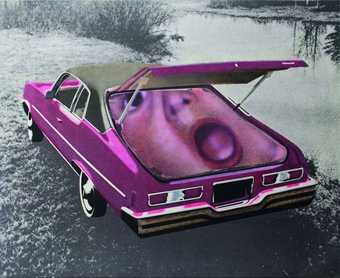Was ‘pop art’ a term used by yourself or colleagues or was there a different terminology that referred to a new figurative art movement in the 1960s and early 1970s?
Someone told me that it related to pop, but to me it seemed odd, apart from the photographic enlargements on canvas which had been used for the first time, I believe, by Rauschenberg in 1954–55. But Rauschenberg wasn’t even a typical representative of pop. They told me he is more dada than pop …

Eulàlia Grau
Panic (Ethnography) 1973
Private collection
© Eulàlia Grau
Did you ever consider yourself (now or in the past) a pop artist?
Anyway, I don’t believe that my origin is pop culture, or at least not too much. My iconography is not pop. One cannot say that in Europe existed a real pop iconography to draw upon, unless it was imported, like for instance Coca-Cola, the USA star system and things of that kind. For instance you can’t categorise as pop iconography Danone or La Fábrica furniture, or similar provincial things – these are phenomena that certainly don’t impact on national iconography. National costumes remain tied to old figuration – very old in some cases – and in a fundamentally rural civilisation: modern imagery has had little or no impact. For me it is impossible – by definition – to make pop with a Catalan character, even if we wanted to, in the same way that it is impossible to make a Catalan western – by this I don’t mean made in Catalonia, I mean a Catalan western. Simply because Catalonia doesn’t have the same history as the West, which is the history of the pioneer cowboys.
Did your work engage with current events in the 1960s and early 1970s?
Art can express anti-establishment or protest themes, including anti-war images, but pro-establishment ideas are also represented, like for instance national anthems, patriotic images and political campaigns.
How did you choose the subject matter for your work included in The World Goes Pop?
The work of an artist is to choose and select. This means that the artist is inclined to share the time in which he/she is living, not only thematically but also in terms of the subjects and how they are expressed in images.
Where did you get your imagery from (what, if any, sources did you use)?
The images then, in the 1970s, were found in mass media, magazines, newspapers, pamphlets …
Were you aware of pop art in other parts of the world?
Yes, of course, I lived in London and Milan and knew the vanguard movements very well.
Was commercial art an influence on your work or the way in which it was made?
No, I don’t think so. I first sold my paintings four years ago to Museo Reina Sofia in Madrid and Macba in Barcelona.
Was there a feeling at the time that you doing something important and new, making a change…?
It was a time of great turmoil in Catalonia, we were all aching for change and were under the illusion that we would achieve it.
Was there an audience for the work at the time – and if so what was their reaction to it?
The majority of the audience were intellectuals and young people, students that were ready for a cultural change, but on the other side we were fiercely criticised by the reactionaries and left wing people with fascist inclinations!
Looking back at these works, what you do think about them now?
I have always been convinced by what I was doing and I still am.
September 2015
